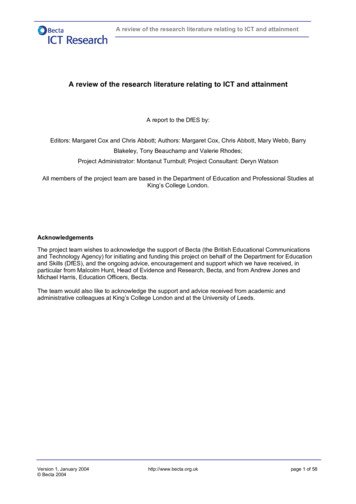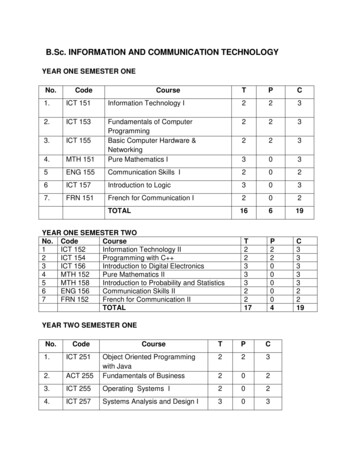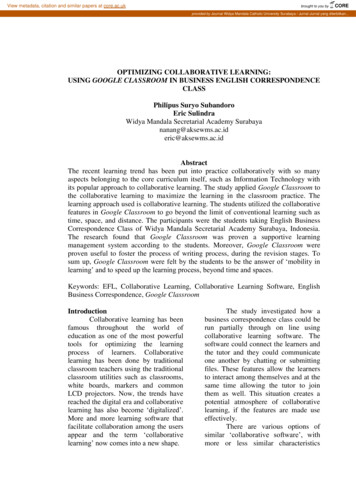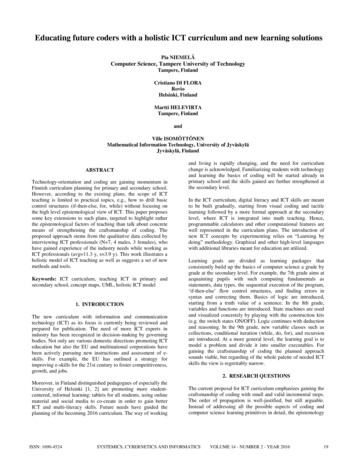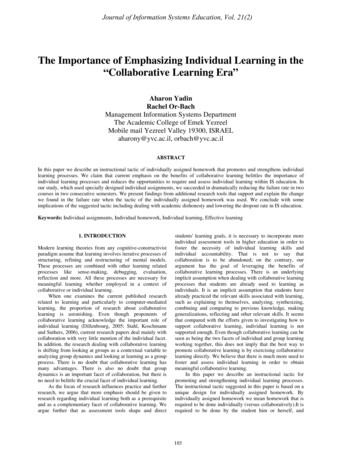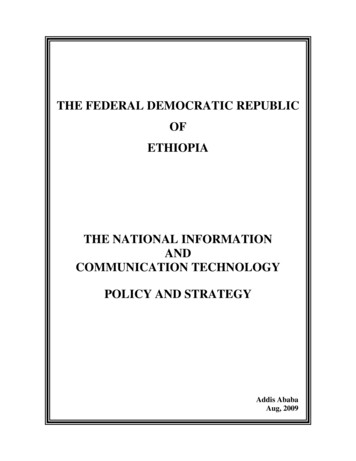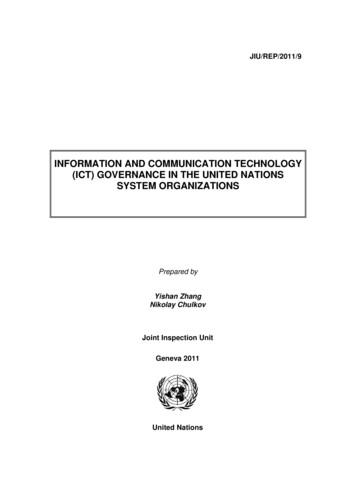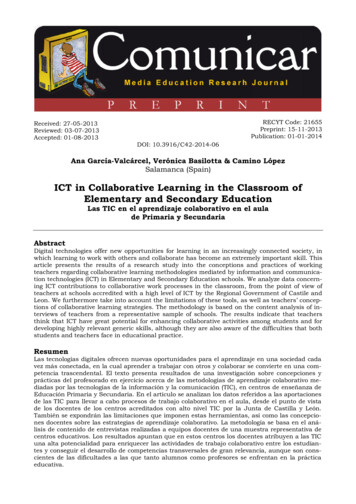
Transcription
RECYT Code: 21655Preprint: 15-11-2013Publication: 01-01-2014Received: 27-05-2013Reviewed: 03-07-2013Accepted: 01-08-2013DOI: 10.3916/C42-2014-06Ana García-Valcárcel, Verónica Basilotta & Camino LópezSalamanca (Spain)ICT in Collaborative Learning in the Classroom ofElementary and Secondary EducationLas TIC en el aprendizaje colaborativo en el aulade Primaria y SecundariaAbstractDigital technologies offer new opportunities for learning in an increasingly connected society, inwhich learning to work with others and collaborate has become an extremely important skill. Thisarticle presents the results of a research study into the conceptions and practices of workingteachers regarding collaborative learning methodologies mediated by information and communication technologies (ICT) in Elementary and Secondary Education schools. We analyze data concerning ICT contributions to collaborative work processes in the classroom, from the point of view ofteachers at schools accredited with a high level of ICT by the Regional Government of Castile andLeon. We furthermore take into account the limitations of these tools, as well as teachers’ conceptions of collaborative learning strategies. The methodology is based on the content analysis of interviews of teachers from a representative sample of schools. The results indicate that teachersthink that ICT have great potential for enhancing collaborative activities among students and fordeveloping highly relevant generic skills, although they are also aware of the difficulties that bothstudents and teachers face in educational practice.ResumenLas tecnologías digitales ofrecen nuevas oportunidades para el aprendizaje en una sociedad cadavez más conectada, en la cual aprender a trabajar con otros y colaborar se convierte en una competencia trascendental. El texto presenta resultados de una investigación sobre concepciones yprácticas del profesorado en ejercicio acerca de las metodologías de aprendizaje colaborativo mediadas por las tecnologías de la información y la comunicación (TIC), en centros de enseñanza deEducación Primaria y Secundaria. En el artículo se analizan los datos referidos a las aportacionesde las TIC para llevar a cabo procesos de trabajo colaborativo en el aula, desde el punto de vistade los docentes de los centros acreditados con alto nivel TIC por la Junta de Castilla y León.También se expondrán las limitaciones que imponen estas herramientas, así como las concepciones docentes sobre las estrategias de aprendizaje colaborativo. La metodología se basa en el análisis de contenido de entrevistas realizadas a equipos docentes de una muestra representativa decentros educativos. Los resultados apuntan que en estos centros los docentes atribuyen a las TICuna alta potencialidad para enriquecer las actividades de trabajo colaborativo entre los estudiantes y conseguir el desarrollo de competencias transversales de gran relevancia, aunque son conscientes de las dificultades a las que tanto alumnos como profesores se enfrentan en la prácticaeducativa.
Keywords / Palabras claveTeaching methodology, curriculum integration, collaborative learning, virtual learning, teachertraining, teaching practice.Metodología didáctica, integración curricular, aprendizaje colaborativo, aprendizaje virtual, formación de profesorado, práctica docente.Dr. Ana García-Valcárcel Muñoz-Repiso is Professor in the Faculty of Education at the Universityof Salamanca, Spain (anagv@usal.es).Verónica Basilotta Gómez-Pablos is a PhD Student at the Department of Didactics and Organizational Research Methods at the University of Salamanca (verobgp@gmail.com).Camino López García is a PhD Student at the Department of Didactics and Organizational Research Methods at the University of Salamanca (caminologa@gmail.com).1. IntroductionDigital technology arrived in Spanish educational centres through various programmes for introducing ICT in the classroom, with one of the newest and mostrelevant programmes being the national Escuela (School) 2.0 developed in Castillaand León under the name Red XXI. Funding for technology has brought computers and smartboards to a large number of classrooms in elementary and secondary schools. Now is a good time to determine the changes this new technology hasbrought about in teaching methods, and the results in terms of student learning.To this end, the GITE-USAL research group at the University of Salamanca is carrying out research on collaborative learning strategies based on ICT use at thoseschools that boast a high level of technology in the region of Castilla and León(research financed by the Ministry of Education, “Aprendizaje colaborativo através de las TIC en el contexto de la Escuela 2.0”; EDU2011-28071).Several decades ago, Piaget stated that «the principle goal of education is to createmen who are capable of doing new things, not simply of repeating what othergenerations have done - men who are creative, inventive and discoverers» (1981).Developing metacognitive, creative, and communicative skills is still an educational goal today, and one that should view learning as a process of acquiring andbuilding knowledge with a strong social and experiential component. Current pedagogy must allow students greater freedom to expand their thinking beyondconventional models, and collaborative learning methods are likely to generatelearning environments that meet this objective. Building and sharing becometransversal objectives for which the use of ICT proves to be quite advantageousfor developing curricula and for teaching students. Education through the exchange of ideas is a far cry from bureaucratic education that values quantity overquality, and reaches out to inner transformation and mobilization. «Through suchtechniques as open discussion, people in small groups may change collectivethinking, learn to mobilize energy and actions toward common goals, and rely onan intelligence that is superior to the sum of the individual talents of the members of the group» (Carneiro, 2009: 20).Collaborative learning methods involve teamwork among students. Various strategies may be used to help students work together to achieve specific common objectives which are the responsibility of all members of the group. Collaborative COMUNICAR, 42 (2014); e-ISSN: 1988-3293; Preprint EditionDOI: 10.3916/C42-2014-06
learning is based on the «construction» theory that assigns an important role tostudents as main protagonists in the learning process. The academic, social andpsychological benefits of this type of learning have been demonstrated by manyauthors, among them Kolloffel, Eysink & Jong (2011), Kozma & Anderson (2002)or Panitz (2004), who highlighted a long list of advantages, such as boostingmega-cognition and permitting students to feel a sense of control over what theyare learning (academic benefits). Collaborative learning encourages students tosee situations from different perspectives, creates an environment where they canpractice social and leadership skills (social benefits), and provides a satisfactorylearning experience that significantly reduces anxiety (psychological benefits).Constructive-collaborative learning works very well with the Internet, placing usin the realm of «collaborative learning using computers» (CSCL: Computer Supported Collaborative Learning), as a new model that unites learning theories withtechnological tools, based on a socio-cultural view of cognition that proposes anessentially social nature for the learning process, and looks to technology for itspotential to create, support and enrich interpersonal contexts for learning (Kolloffel, Eysink & Jong, 2011; García, Gros & Noguera, 2010; Gómez, Puigvert & Flecha, 2011; Salmerón, Rodríguez & Gutiérrez, 2010).According to this model, it is the role of information and communication technologies (ICT) to offer new possibilities for social intervention, to create collaborative learning environments (communities) that allow students to carry out groupactivities, activities that are integrated into the real world and planned with realobjectives. Research in this area consistently points out the necessity of preparing technology to be used as a tool rather than as an end in and of itself, a toolthe main purpose of which is to help students learn in a more efficient manner.Helping others to learn has to do with offering better channels for communicationas well as better tools for exploring the domain that holds the primary materialsfor learning (Coll, Maurí & Onrubia, 2008; García-Valcárcel & Hernández, 2013).Teachers at innovative European secondary schools who make significant use ofICT to support learning based on problem-solving report improvements in concepts and skills, motivation, responsibility and self-reliance (OCDE, 2003). Fortheir part, the teachers and students who participate in collaborative learningprojects with other schools express a high degree of satisfaction, especially concerning communication with students from other countries, as can be seen in theevaluation reports from the eTwinning project (Baca, 2010).Data from a study published by Sáez (2011) reveal that almost half of teachersmaximize self-reliance and individual work using ICT, and 40% of teachers makeuse of ICT for collaborative and group activities using technology.In studies carried out in Latin America (Murillo & Martínez-Garrido, 2013;Puentes & al., 2013; Román & Murillo, 2012), the conclusion is that teachers areaware of the potential that ICT possess as motivators for the teaching-learningprocess, and that they also recognize that they promote collaborative learning.In Spain, and specifically in the region of Castilla and León, the use of collaborative learning methods using ICT is both new and complex, even though technological tools are positively valued in the sense pointed out by Suárez & Gros(2013: 56): «The use of tools that allow for communication, collaboration and the COMUNICAR, 42 (2014); e-ISSN: 1988-3293; Preprint EditionDOI: 10.3916/C42-2014-06
acquisition of knowledge is fundamental for improving learning processes.» (p.56). The main advantages that they point out have to do with easing communication (Plomp & Voogt, 2009). The official website for the Escuela (School) 2.0 initiative lists seven advantages of using ICT as part of collaborative learning and workprocedures: efficiency, moral values, the exchange of information, innovation, limitation of duplicities, viability and unity.ICT use has also been correlated with increased learning as it promotes betterinteraction between teachers and students. For Carrió (2007), collaborative learning is simply a very useful way of teaching in that students and teachers worktogether, whatever the subject matter. In his opinion, if we were to add technological advances to this model as they occurred, we would, at the same time, increase learning.As far as drawbacks or disadvantages to collaborative learning using ICT, Suárez& Gros (2013: 59) use the following words to refer to planning for activities, «collaborative learning requires much greater preparation in order for students to beable to work independently in groups»; «The difficulties encountered in carryingout collaborative processes are usually the result of poorly designed activities andproblems with communication and organization of those activities rather thanwith technical aspects of the programs or platforms used.» They also note thatICT «actually aggravate conflict when teachers misinterpret messages or whenmultiple messages that need to be answered immediately are received» (57-58).On the other hand, we find a lack of experience on the part of students with thistype of method and with the tools they must use in virtual environments, whichare frequently poorly thought out in terms of promoting work that is both continuous and easy to evaluate.The other great disadvantage has to do with the time factor, an aspect that hasalso been mentioned in several research papers on the subject. Ferrero, Martinez& Otero (2009: 8) state that the use of ICT requires much more teacher time thando conventional methods. «Internet communication requires enough time to readand answer messages, and to surf the web, which may cause teachers to feeloverwhelmed. Clearly, far from saving time, the use of ICT may actually use uptime that could otherwise be spent performing other tasks that are also a part ofa teacher s responsibility.»Finally, we should point out the importance of relating these methods based oncollaboration and the use of ICTs to build knowledge with the variables that affectstudent performance- skills acquisition, motivation, satisfaction, etc. Studies ofinterest in this respect include those by Camilli, López & Barceló, 2012; Cox &Marshall, 2007; García-Valcárcel & Tejedor (2010); Martín & Tyner (2012); Monereo & Badía (2012); Rué (1998); Tejedor (2010); Zaho & Kenneth (2002).2. Research methodsThe objective of this study was to determine the conceptions held by teacherswho work in schools that are well-equipped with information and communicationtechnology (ICT) as to the advantages and disadvantages of collaborative learningmethods based on their own teaching experience. COMUNICAR, 42 (2014); e-ISSN: 1988-3293; Preprint EditionDOI: 10.3916/C42-2014-06
At the same time, our study sought to discover to what extent teachers value anduse ICT to support collaborative work projects for students as well as for theirown professional development.We chose a method that was qualitative in nature so that we could straightforwardly explore teacher conceptions regarding the potential value of collaborativelearning processes, their actual classroom experiences with collaborative workactivities, and the role that ICT play in these activities. Our technique for gathering information comprised interviews with key persons at the schools; specifically,we spoke with groups of teachers in primary (third cycle) and secondary (firstcycle) levels of education who teach at schools that have well-developed technological infrastructures. The population of interest was defined as schools that havereceived ICT accreditation (level 4 and 5) from the Junta of Castillaand León for2010 and 2011, and again, specifically, teachers who work at the educational levels mentioned above, since they are the ones directly involved in the Red XXIProgram for the region of Castilla and León. Twenty schools from the followingprovinces agreed to participate in the study and form the sample group: 2 schoolsin León, 2 in Palencia, 4 in Burgos, 1 in Soria, 3 in Valladolid, 2 in Zamora, 2 inSalamanca, and 4 in Segovia. Of these schools, 11 are city schools while the other9 should be considered rural schools; there are 14 schools with pre-school andprimary classes (CEIP), 2 secondary schools (IES), 2 compulsory educationschools (CEO), and 3 clustered rural schools (CRA). The latter are schools thatare part of a group of small schools in several nearby villages.Field work was carried out during the school year 2011-12. In all cases, the administrators of each school had given their approval for the interviews, and anordinary semi-structured protocol was applied. Each interview was led by a researcher with participation by a group of primary (third cycle) and/or secondary(first cycle) teachers at the school, teachers who taught different subjects, and anICT coordinator whenever possible.In analysing the interviews we focused on the advantages and disadvantages thatteachers perceived in collaborative learning strategies oriented both towards students and towards their own professional development, since these are the considerations that determine to a great extent the practices that teachers carry out.Thus, using the information from the interviews on our topic, we inductivelycreated a set of categories which, in turn, was validated by experts and subjectedto control through double categorization of 5 interviews by two different researchers, obtaining a high index of reliability as revealed by the high degree of correlation between the two. We used the NVivo10 program to analyse the contents ofthe interviews and that provided us with frequencies for the categories and allowed us to compare the opinions from each school using cluster analysis and theJaccard index.3. ResultsAt first glance, a general calculation of the textual units referring to the advantages and disadvantages of collaborative learning and the use of ICT indicatesthat the teachers interviewed identified many more advantages than disadvantages. Specifically, there are 101 textual references to advantages as opposed to 76 COMUNICAR, 42 (2014); e-ISSN: 1988-3293; Preprint EditionDOI: 10.3916/C42-2014-06
mentions of disadvantages, i.e. 57% as opposed to 43% of interventions in thissense.3.1. Advantages of Collaborative Learning and the Use of ICTThe main advantages that teachers attribute to collaborative learning are relatedto «developing transversal skills, », «interaction among students» and «curriculumdevelopment». They also make frequent reference to increased student learning,motivation, and the repercussions of collaborative learning on students withlearning disabilities. Table 1 shows the frequency of mention for the various categories related to the advantages of collaborative learning:Table 1. Adventages of Collaborative LearningCategoriesFrequenciesDevelopment of transversal learning skills8Interaction among students7Curriculum development6Increase in student attention and participation4Improvements in teacher professional development4Increased student learning4Increased motivation3Improvements in performance among students with learning3disabilitiesEvaluation of student learning2Promoting personal satisfaction for students1Promoting family participation1The transversal learning skills mentioned refer to social skills (such as respect),problem solving, and work habits (self-reliance, responsibility, organization ),plus the capacity for reflection, critical thinking, and initiative. Below are a fewnotable references to these skills: «They are more critical when it comes to carrying out tasks. Since they haveaccess to more material, they discuss things more among themselves, insuch ways as, what do we all think?, what do we want to do?, I think thisbit would be better farther up or farther down in our writing.» interview 14). «To learn to learn, so that in the future they will know how to do things forthemselves, how to cooperate with others, to work as a team, to speak inpublic, and all these kinds of things. That is what is really going to be ofvalue to them in the future» (interview 2). «Yes, and especially camaraderie, getting along with others, being able towork with others, knowing how to fit in with the world, in society, to respect differences and opinions» (interview 6). Regarding curriculum development, teachers expressed the following: -«Less and less time is spent transmitting information. The student getsbored less and the teacher has more time to truly evaluate, and can be COMUNICAR, 42 (2014); e-ISSN: 1988-3293; Preprint EditionDOI: 10.3916/C42-2014-06
there with the student groups, lending support, observing . At the sametime you can be evaluating; you are able to follow the learning processmuch better» (interview 2). -«Working collaboratively, students create digital walls on which each student, depending on the subject he has been given, places an image and acommentary. They also use Webquest. For history class, one teacher uses atimeline with slides where students look for images and add data» (interview 14).Graph 1 shows the different points that teachers identified as the advantages ofcollaborative learning using ICT. The notion they mention most often is that «theyfacilitate student work», which includes the following subcategories: they economize student work, they motivate students, they grab students attention, theypromote student responsibility and self-reliance as they carry out their tasks,they help students with learning disabilities, ICT can be adapted to each student s level, and student learning increases.Rated second as an important advantage are «promoting interaction and communication» and «changes in approaches to teaching».Graph 1. Advantages of Using ICT with Collaborative Learning.Teachers point out the high level of motivation for collaborative learning that digital tools inspire in students, as can be seen in the following opinions: «ICT provide the motivational component for collaborative projects» (interview 17). «Students help each other and it s easier for them to work collaborativelywith the computer than with traditional materials (paper and pencil); theprocess becomes more practical» (interview 5). The following teacher opinions regarding including students with learningdisabilities are especially interesting: COMUNICAR, 42 (2014); e-ISSN: 1988-3293; Preprint EditionDOI: 10.3916/C42-2014-06
«Somehow, the ones that truly grasp or understand the project pull theothers along; the ones doing the work bring the others up to the group littleby little, and in the end we have a homogenous bunch» (interview 18). «The use of ICT with collaborative projects has an added value, which isthat it promotes the integration of students with learning disabilities» (interview 6).3.2. Disadvantages of Collaborative Learning and the Use of ICTEven though the various schools all consider collaborating work as fundamental,they also describe a few disadvantages, in many cases related to curriculum development (table 2):Table 2. Disadvantages of Collaborative LearningCategoriesCurriculum DevelopmentPressure from the Educational System and the Official CurriculaAspects Related to School OrganizationLearning OutcomesExpectations of Families in Favour of Traditional MethodsTeacher PracticesFrequencies1255411Some aspects related to curriculum development, such as time wasted in theclassroom, loss of control over students, differences in level of involvement amongstudents in the group (the more self-reliant direct the work, the least reliant justgo along), inherent limitations because of students being so young (too young tobe left on their own), student evaluation more difficult and incoherent (studentsevaluated individually even though they are working collaboratively), and difficulty in applying collaborative learning to all subjects are the major obstacles thatteachers perceive when using collaborative learning-teaching strategies. Beloware a few examples along these lines: «Collaborative activities with ICT are usually used with subjects that carryless academic weight» (interview 10). «They are very needy; sometimes I have to not deny them help, but certainly delay giving it because otherwise they have a tendency to take theeasy road, which is the way they think solves all their problems» (interview8). «There is a contradiction in that what is proposed is that the work be donecollaboratively, as a group, but then the exams be taken individually» (interview 16)Teachers also feel that collaborative learning with ICT means a lot of work andeffort, that is to say, that it requires very good planning and, above all, time toprepare the sessions (see graph 2). Some teachers do not see the added value ofICT for collaborative learning. They also feel that students already have certainwork habits regarding computers that make collaboration difficult, such as computer game expectations, individualized work, and difficulties with reading (they COMUNICAR, 42 (2014); e-ISSN: 1988-3293; Preprint EditionDOI: 10.3916/C42-2014-06
copy and paste text without reading it first). They express themselves in the following manner with respect to planning efforts:o «It requires much more preparation beforehand. You have to haveeverything very well prepared in advance; before you start, you haveto figure out more or less what will be confusing for the children soyou can guide them as they work» (interview 12).o «The drawback with collaborative work with ICT is the time needed toprepare for it. It’s different because you have to gather together a lotof information; you have to choose the information that suits whatyou’re trying to accomplish; well, it’s more work but the results areperhaps better» (interview 18).Graph 2. Disadvantages of Using ICT for Collaborative Learning.3.3. Comparative Analysis of Teachers from Different SchoolsCluster analysis was used as a multivariable technique to classify our set of interviews into homogeneous groups. This markedly exploratory type of analysiswas used to measure similarity (or difference) in content in function of the codification that we set up. Similarity was calculated by comparing all the interviews inpairs using the Jaccard index, a coefficient that makes comparisons based onpresence-absence data.Graphs 3 and 4 show the similarity codifications between schools. A high degreeof similarity is observed in some cases such as 5 and 11, or 14 and 20, whichwould indicate that the teachers in these schools, in general, share the same opinions. In any case, no interview was observed to be significantly different from therest, a fact that allows us to confirm the cohesion of opinions expressed by thedifferent sets of teachers. COMUNICAR, 42 (2014); e-ISSN: 1988-3293; Preprint EditionDOI: 10.3916/C42-2014-06
Schools Grouped According toSimilarity in CodificationGraph 3. Graphic representation ofSimilarity Between Schools.Schools Grouped According toSimilarity in CodificationGraph 4. Tree Graph of Similarity Between Schools.As we can see in graphs 3 and 4, the interviews or sets of teachers that are mostdistant one from the other in their conceptions about the subject at hand, according to the codification we carried out, are interviews 4 and 15 which correspond to two urban schools located in the province of Burgos. At one of theschools the teachers pointed out more advantages than disadvantages whenspeaking about collaborative learning and the use of ICT. We note, as an example: «Collaborative work produces improvements at both the individual and collective level, students are more motivated, ICT favour inclusion, and teachers learn alot when they collaborate among themselves» (interview 4). At the same time, atthe other school, teachers pointed out more disadvantages, stating: «ICT do notprovide any added value for collaborative work; maybe when society becomes better prepared, because it is too individualistic. There is extra effort in creating materials and an increase in time spent on preparing students to handle the technology» (interviews 15). We feel that such different opinions between these schoolsmay be linked, among other things, to the existence or not of an ICT coordinator.At the first of the two schools, there is a person who carries out these functionsand who develops training plans for the school, while also conferring with staffvirtually. On the other hand, at the second school, the headmaster must also playthe role of ICT coordinator, which means that this person has less time to devoteto ICT.3.4. Analysis of the Context of the Concept «Collaborative»We chose the key word «collaborative» to analyse in its context, creating the wordand sentence tree shown in figure 1. This tree shows the sentences from the dif COMUNICAR, 42 (2014); e-ISSN: 1988-3293; Preprint EditionDOI: 10.3916/C42-2014-06
ferent interviews in which the selected term appears and the number in parenthesis tells which interview they came from.Figure 1.Word and Sentence Tree for the Key Word «Collaborative».There are some especially interesting ideas on the tree for analysing the subjectat hand and that summarize in one way or the other the ideas expressed by thisset of teachers as far as the potential of ICT and collaborative learning, but alsoits weak points or the demands it makes on teachers: «ICT provide many benefitsfor collaborative learning»; «Collaborative learning is easier with technology»;«Students like collaborative learning»; «ICT make it easier to carry outcollaborative projects»; «It kindles student interest»; «It increases studentmotivation»; «It is a very good way to meet the needs of diverse students»; «Thereare teachers who do not get sufficiently involved»; «Collaborative learning isdifficult to carry out»; «Collaborative learning has the drawback of having to bethoroughly prepared beforehand»; «Collaborative work but then individualexams»; «There is a lack of tools for evaluation»; «It would take time away fromother topics to be covered in the class».4. Discussion and conclusionsThe data we analysed clearly shows that the conceptions held by teachers whowork in schools that are well-equipped with ICT regarding the potential forcollaborative learning and the use of ICT for its implementation are complex andreflect both the positive aspects and the limitations of this type of educationalpractices.The principal advantages of collaborative learning are those related to developingtransversal skills that stimulate social skills, problem solving, self-reliance,responsibility, and the capacity for reflection and initiative, all of which are COMUNICAR, 42 (2014); e-ISSN: 1988-3293; Preprint EditionDOI: 10.3916/C42-2014-06
considered of great relevance by teachers for achieving a well-rounded educationfor students. As for ICT, they are valued for the way they facilitate student work,giving them more independence, motivating them, grabbing their attention, andadapting to varying student levels, which especially supports students withlearning disabilities, while increasing learning for all students.These results coincide with those of other researchers (Alfageme, 2003; Cabero,1994; García-Valcárcel & Tejedor, 2010; Lee & Tsai, 2013), who note thatcollaborative learning is a strategy for improving the acquisition and retention ofknowledge, one that enhances specific strategies that students may use whenacquiring know
Constructive-collaborative learning works very well with the Internet, placing us in the realm of «collaborative learning using computers» (CSCL: Computer Sup-ported Collaborative Learning), as a new model that unites learning theories with technological tools, based on a socio-cultural view of cognition that proposes an
